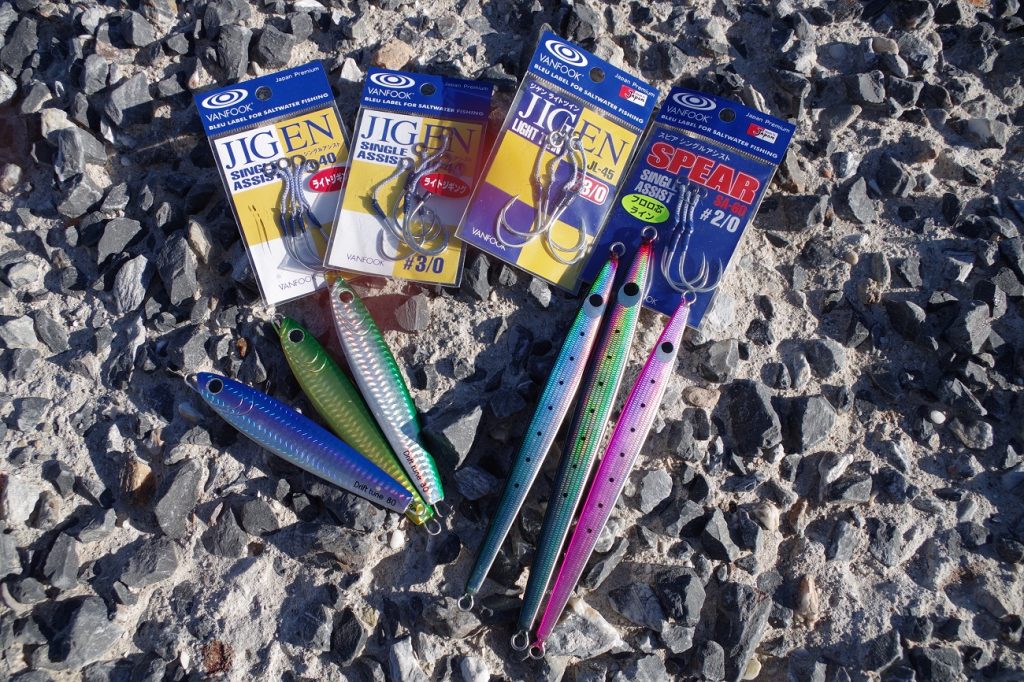Shore jigging: Types of assist hooks

Another thing that plays a very important role on the rate of succeed catches, is the hook itself. For sure not all hooks are ideal for making assist hooks and there are many types of specialized assist hooks that perform better depending on the circumstances. But let’s get things from start. A hook depending its weight and type, can affect the jigs action and can also play part in secondary roles beyond your imagination. So here is the real deal.

Weight: The heavier the metal of the hook is, the more susceptible to bottom snagging it is. A heavy hook on the “landing” of the jig to a rocky bottom tends to hang from the sides and snag on any available rock. Light hooks touch lighter and slower the bottom and is more difficult to snag. Even if so, they release their grip easier. Heavy hooks also affect the action on the jig negatively and do not allow it to expose its real value. Also heavy hooks while jigging, they tend to hit hard the jig and damage its finish and color. Another critical thing is that on the last moment of the attack, the attacking fish sucks water in order to bring its victim closer to the mouth. This suction is capable to bring a lighter hook inside the mouth, but not so easy a heavier one. I have to admit that in the past I was using only heavier assist hooks but now I have completely enter lighter ones depending the needs of my fishing. Modern Assist hooks try to be as light and strong as they can and this is why even in some models, the ring is absent and the flat surface is back to business.

Material: Modern metal chemistry is on a higher level and this by itself gives to the angler excellent hooks with unique characteristics. But what do we really need from our hook? We need it to be light, unbendable, sharp, tough and rust resistant. In the past all those things on a hook was just a future dream, but now there are several Japanese brands like, Vanfook, Owner, Gamakatsu, etc that make super hooks for the demanding angler.
Shape: The straighter the point of the hook is, the deeper it hooks the fish but it needs a strong attack. Curved points on the other hand tend to hook fish on the slightest touch and from everywhere on the body, but this hook ups sometimes are not strong and deep and tear the fish eventually. Also all shore jigging hooks are completely straight when you look at them from in front, in addition with bait hooks that bend.

Thickness: Well there are thick hooks and there are thin hooks. It is very important to understand when to use each. Thicker hooks tend to hook deep and keep the fish without tearing it even by strong rods. The thicker the hooks are, protect the hooked area from tearing, but penetrating on a hard spot is a bit of a problem. Thinner hooks have excellent penetrating ability and can also hook fish on the falling with the help of the jigs weight. But as someone can expect, they tear the fish when they hook it on flesh especially with harder rods. Remember, thick hooks are better used with faster and stronger rods and thinner, with more moderate rods. Both after the strike need a second hooking, more gentle with thin hooks and stronger with thick ones.

No matter if you are the type of guy that likes to make assist hooks by himself or buy ready ones, I suggest to use excusive for shore jigging. Try to use constantly hooks made for this amazing technique so to be sure that you leave luck out of your game. Remember that also jigging hooks on smaller sizes are ideal on this fishing. Slow jigging hooks work well but this is another chapter that I’m about to talk soon about.





